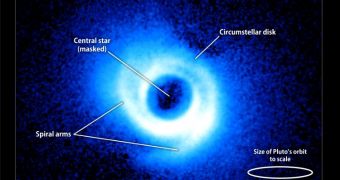According to an astronomer at the NASA Goddard Space Flight Center (GSFC), in Greenbelt, Maryland, the presence of forming extrasolar planets around a young star can be detected by looking for spiral arms forming within the protoplanetary disk around said star.
A protoplanetary disk is a circular structure forming around a very young stars, which is made up of all the material that existed within the molecular cloud from which the star collapsed. In other words, it represents some excess material that did not fall into the star when the latter formed.
The material naturally comes together as a disk, made up of cosmic dust, hydrogen gas, and a number of other constituents. Over short geological time frames – of only several millions of years – particles in the disk begin to clump together.
At first, only small pebbles and rocks forms but, as time passes, larger and larger chunks of rock form. Eventually, protoplanets take shape, of which several would go on to become either rocky or gas giant planets. Until now, researchers believed that the formation process was hidden from view.
They argued that the protoplanetary disk was simply too thick to allow for the detection of forming exoplanets directly. However a small minority of investigators proposed that the formation of new objects in the disk must leave behind telltale signs, such as for example the formation of spiral arms.
“Detailed computer simulations have shown us that the gravitational pull of a planet inside a circumstellar disk can perturb gas and dust, creating spiral arms. Now, for the first time, we're seeing these dynamical features,” GSFC and Eureka Scientific Inc. astrohnomer Carol Grady says.
She and her team presented the results of a new study on the issue at the Signposts of Planets meeting, which was held today, October 19, at the GSFC. The data the expert used were collected from the Strategic Exploration of Exoplanets and Disks with Subaru (SEEDS) survey.
“What we're finding is that once [new star] systems reach ages of a few million years, their disks begin to show a wealth of structure – rings, divots, gaps and now spiral features,” expert John Wisniewski adds.
“Many of these structures could be caused by planets within the disks,” adds the investigator, who holds an appointment at the University of Washington in Seattle. He was also a part of the team that conducted the new study.

 14 DAY TRIAL //
14 DAY TRIAL //